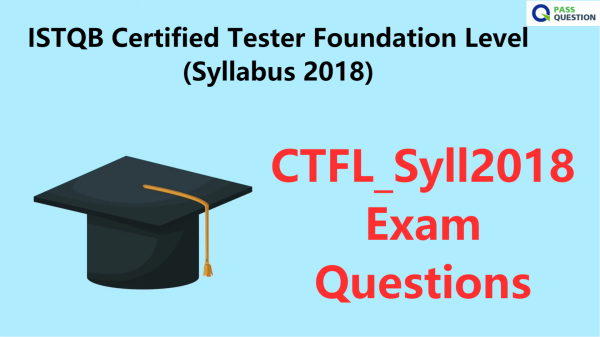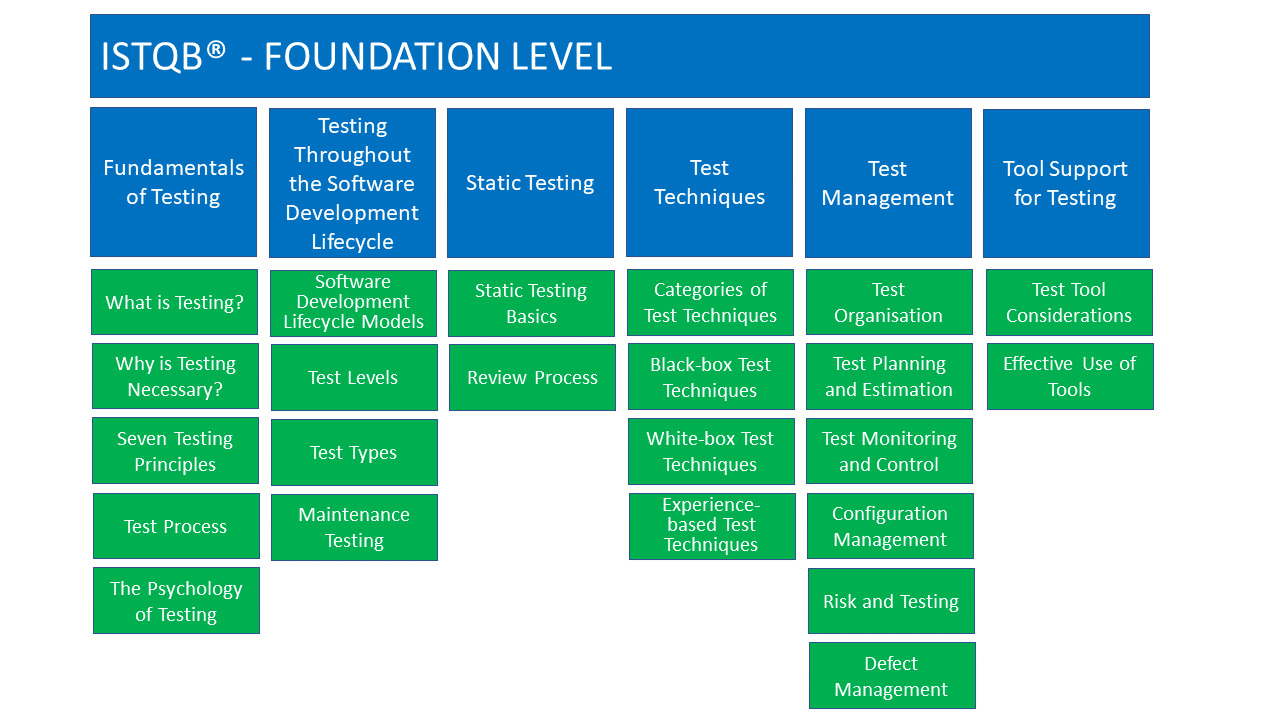CTFL_Syll2018 Exam Questions - ISTQB Certified Tester Foundation Level (Syllabus 2018)
ISTQB Foundation Level 2018 Certification is one of the most popular exams among IT candidates, CTFL_Syll2018 exam is a pre-requisite to other ISTQB certifications where Foundation Level is required. You can choose PassQuestion CTFL_Syll2018 Exam Questions for your ISTQB Foundation Level 2018 Certification Exam. Our CTFL_Syll2018 Exam Questions are enough to prepare you best for your coming CTFL_2018 Exam. PassQuestion guarantees that you will be easily able to succeed in your ISTQB Foundation Level 2018 Certification Exam.

ISTQB Certified Tester Foundation Level 2018
The Foundation Level Syllabus forms the basis for the International Software Testing Qualification at the Foundation Level. The new 2018 syllabus is recognised as a pre-requisite to other ISTQB certifications where Foundation Level is required.
The 2018 Foundation Level qualification is suitable for anyone who needs to demonstrate practical knowledge of the fundamental concepts of software testing including people in roles such as testers, test analysts, test engineers, test consultants, test managers, user acceptance testers and software developers.
This Foundation Level qualification is also appropriate for anyone who wants a basic understanding of software testing, such as project managers, quality managers, software development managers, business analysts, IT directors and management consultants. Holders of the Foundation Certificate will be able to go on to a higher level software testing qualification.
Exam Structure
The Foundation Level exam CTFL-2018 is comprised of 40 multiple-choice questions, with a pass mark grade of 65% to be completed within 60 minutes. Participants that take the exam not in their spoken language, will receive additional 25% time, for a total of 75 minutes.

Learning Objectives

The 2018 Foundation Level Learning objectives are as follows:
Chapter 1 Fundamentals of Testing
1.1 What is Testing?
LO-1.1.1 Identify typical objectives of testing (K1)
LO-1.1.2 Differentiate testing from debugging (K2)
1.2 Why is Testing Necessary?
LO-1.2.1 Give examples of why testing is necessary (K2)
LO-1.2.2 Describe the relationship between testing and quality assurance and give examples of how testing contributes to higher quality (K2)
LO-1.2.3 Distinguish between error, defect, and failure (K2)
LO-1.2.4 Distinguish between the root cause of a defect and its effects (K2)
1.3 Seven Testing Principles (K2)
LO-1.3.1 Explain the seven principles of testing (K2)
1.4 Test Process
LO-1.4.1 Explain the impact of context on the test process (K2)
LO-1.4.2 Describe the test activities and respective tasks within the test process (K2)
LO-1.4.3 Differentiate the work products that support the test process (K2)
LO-1.4.4 Explain the value of maintaining traceability between the test basis and the test work products (K2)
1.5 The Psychology of Testing (K2)
LO-1.5.1 Identify the psychological factors that influence the success of testing (K1)
LO-1.5.2 Explain the difference between the mindset required for test activities and the mindset required for development activities (K2)
Chapter 2 Testing Throughout the Software Development Lifecycle
2.1. Software Development Lifecycle Models
LO-2.1.1 Explain the relationships between software development activities and test activities in the software development lifecycle (K2)
LO-2.1.2 Identify reasons why software development lifecycle models must be adapted to the context of project and product characteristics (K1)
LO-2.1.3 Recall characteristics of good testing that are applicable to any life cycle model (K1)
2.2 Test Levels (K2)
LO-2.2.1 Compare the different test levels from the perspective of objectives, test basis, test objects, typical defects and failures, and approaches and responsibilities (K2)
2.3 Test Types (K2)
LO-2.3.1 Compare functional, non-functional and white-box testing (K2)
LO-2.3.2 Recognize that functional and structural tests occur at any test level (K1)
LO-2.3.3 Recognize that functional, non-functional and white-box tests occur at any test level (K1)
LO-2.3.4 Compare the purposes of confirmation testing and regression testing (K2)
2.4 Maintenance Testing (K2)
LO-2.4.1 Summarize triggers for maintenance testing (K2)
LO-2.4.2 Describe the role of impact analysis in maintenance testing (K2)
LO-2.4.3 Describe the role of impact analysis in maintenance testing (K2)
Chapter 3 Static Testing
3.1 Static Testing Basics
LO-3.1.1 Recognize types of software work product that can be examined by the different static testing techniques (K1)
LO-3.1.2 Use examples to describe the value of static testing (K2)
LO-3.1.3 Explain the difference between static and dynamic techniques, considering objectives, types of defects to be identified, and the role of these techniques within the software lifecycle (K2)
3.2 Review Process
LO-3.2.1 Summarize the activities of the work product review process (K2)
LO-3.2.2 Recognize the different roles and responsibilities in a formal review (K1)
LO-3.2.3 Explain the differences between different review types: informal review, walkthrough, technical review and inspection (K2)
LO-3.2.4 Apply a review technique to a work product to find defects (K3)
LO-3.2.5 Explain the factors that contribute to a successful review (K2)
Chapter 4 Test Techniques
4.1 Categories of Test Techniques
LO-4.1.1 Explain the characteristics, commonalities, and differences between black-box test techniques, white-box test techniques and experience-based test techniques (K2)
4.2 Black-box Test Techniques
LO-4.2.1 Apply equivalence partitioning to derive test cases from given requirements (K3)
LO-4.2.2 Apply boundary value analysis to derive test cases from given requirements (K3)
LO-4.2.3 Apply decision table testing to derive test cases from given requirements (K3)
LO-4.2.4 Apply state transition testing to derive test cases from given requirements (K3)
LO-4.2.5 Explain how to derive test cases from a use case (K2)
4.3 White-box Test Techniques
LO-4.3.1 Explain statement coverage (K2)
LO-4.3.2 Explain decision coverage (K2)
LO-4.3.3 Explain the value of statement and decision coverage (K2)
4.4 Experience-based Test Techniques
LO-4.4.1 Explain error guessing (K2)
LO-4.4.2 Explain exploratory testing (K2)
LO-4.4.3 Explain checklist-based testing (K2)
Chapter 5 Test Management
5.1 Test Organization
LO-5.1.1 Explain the benefits and drawbacks of independent testing (K2)
LO-5.1.2 Identify the tasks of a test manager and tester (K1)
5.2 Test Planning and Estimation
LO-5.2.1 Summarize the purpose and content of a test plan (K2)
LO-5.2.2 Differentiate between various test approaches (K2)
LO-5.2.3 Give examples of potential entry and exit criteria (K2)
LO-5.2.4 Apply knowledge of prioritization, and technical and logical dependencies, to schedule test execution for a given set of test cases (K3)
LO-5.2.5 Identify factors that influence the effort related to testing (K1)
LO-5.2.6 Explain the difference between two estimation techniques: the metrics-based technique and the expert-based technique (K2)
5.3 Test Monitoring and Control
LO-5.3.1 Recall metrics used for testing (K1)
LO-5.3.2 Summarize the purposes, contents, and audiences for test reports (K2)
5.4 Configuration Management
LO-5.4.1 Summarize how configuration management supports testing (K2)
5.5 Risks and Testing
LO-5.5.1 Define risk level by using likelihood and impact (K1)
LO-5.5.2 Distinguish between project and product risks (K2)
LO-5.5.3 Describe, by using examples, how product risk analysis may influence thoroughness and scope of testing (K2)
5.6 Defect Management
LO-5.6.1 Write a defect report, covering defects found during testing (K3)
Chapter 6. Tool Support for Testing
6.1 Test tool considerations
LO-6.1.1 Classify test tools according to their purpose and the test activities they support (K2)
LO-6.1.2 Identify benefits and risks of test automation (K1)
LO-6.1.3 Remember special considerations for test execution and test management tools (K1)
6.2 Test Planning and Estimation (K3)
LO-6.2.1 Identify the main principles for selecting a tool (K1)
LO-6.2.2 Recall the objectives for using pilot projects to introduce tools (K1)
LO-6.2.3 Identify the success factors for evaluation, implementation, deployment and on-going support of test tools in an organization (K1)
- TOP 50 Exam Questions
-
Exam
All copyrights reserved 2025 PassQuestion NETWORK CO.,LIMITED. All Rights Reserved.

